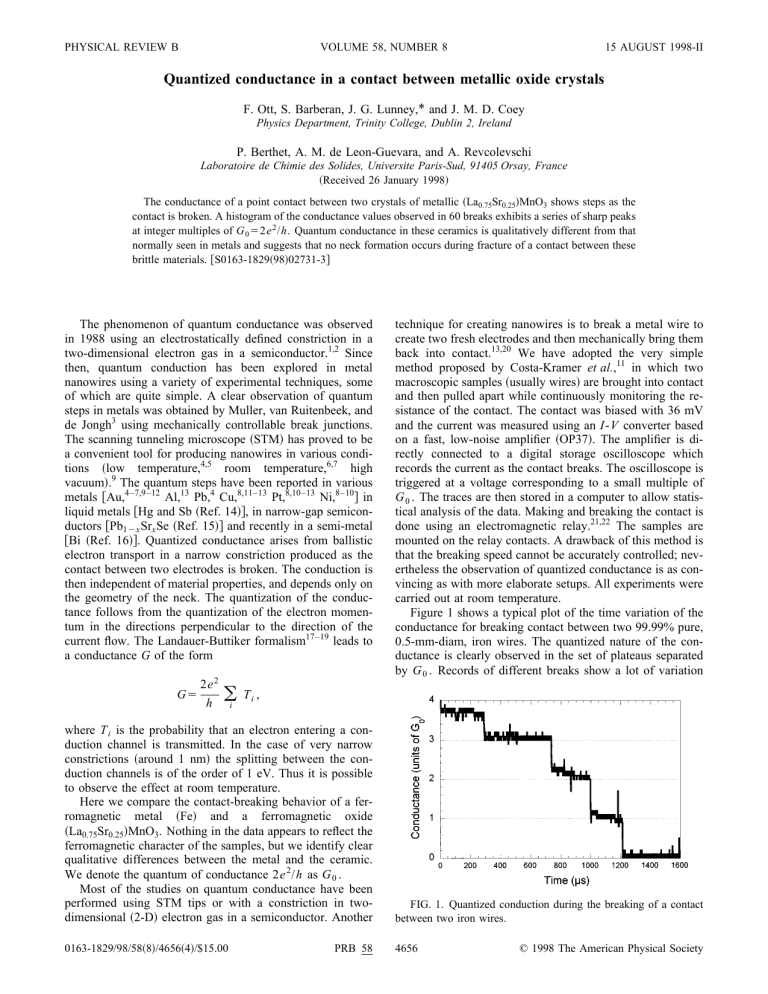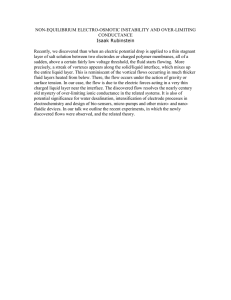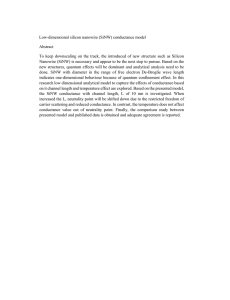Quantized conductance in a contact between metallic oxide

PHYSICAL REVIEW B VOLUME 58, NUMBER 8 15 AUGUST 1998-II
Quantized conductance in a contact between metallic oxide crystals
F. Ott, S. Barberan, J. G. Lunney, * and J. M. D. Coey
Physics Department, Trinity College, Dublin 2, Ireland
P. Berthet, A. M. de Leon-Guevara, and A. Revcolevschi
Laboratoire de Chimie des Solides, Universite Paris-Sud, 91405 Orsay, France
~
Received 26 January 1998
!
The conductance of a point contact between two crystals of metallic
~
La
0.75
Sr
0.25
!
MnO
3 shows steps as the contact is broken. A histogram of the conductance values observed in 60 breaks exhibits a series of sharp peaks at integer multiples of G
0
5 2e 2 /h. Quantum conductance in these ceramics is qualitatively different from that normally seen in metals and suggests that no neck formation occurs during fracture of a contact between these brittle materials.
@
S0163-1829
~
98
!
02731-3
#
The phenomenon of quantum conductance was observed in 1988 using an electrostatically defined constriction in a two-dimensional electron gas in a semiconductor.
1,2
Since then, quantum conduction has been explored in metal nanowires using a variety of experimental techniques, some of which are quite simple. A clear observation of quantum steps in metals was obtained by Muller, van Ruitenbeek, and de Jongh
3 using mechanically controllable break junctions.
The scanning tunneling microscope
~
STM
!
has proved to be a convenient tool for producing nanowires in various conditions
~ low temperature,
4,5 vacuum
!
.
9 metals
@
Au,
4–7,9–12
Al,
13
Pb,
4 room
The quantum steps have been reported in various
Cu,
8,11–13 temperature,
Pt,
8,10–13
6,7
Ni,
8–10 high
# in liquid metals
@
Hg and Sb
~
Ref. 14
!#
, in narrow-gap semiconductors
@
Pb
1
2 x
Sr x
Se
~
Ref. 15
!# and recently in a semi-metal
@
Bi
~
Ref. 16
!#
. Quantized conductance arises from ballistic electron transport in a narrow constriction produced as the contact between two electrodes is broken. The conduction is then independent of material properties, and depends only on the geometry of the neck. The quantization of the conductance follows from the quantization of the electron momentum in the directions perpendicular to the direction of the current flow. The Landauer-Buttiker formalism
17–19 leads to a conductance G of the form
G
5
2e
2 h
( i
T i
, where T i is the probability that an electron entering a conduction channel is transmitted. In the case of very narrow constrictions
~ around 1 nm
!
the splitting between the conduction channels is of the order of 1 eV. Thus it is possible to observe the effect at room temperature.
Here we compare the contact-breaking behavior of a ferromagnetic metal
~
Fe
!
and a ferromagnetic oxide
~
La
0.75
Sr
0.25
!
MnO
3
. Nothing in the data appears to reflect the ferromagnetic character of the samples, but we identify clear qualitative differences between the metal and the ceramic.
We denote the quantum of conductance 2e
2
/h as G
0
.
Most of the studies on quantum conductance have been performed using STM tips or with a constriction in twodimensional
~
2-D
!
electron gas in a semiconductor. Another
0163-1829/98/58
~
8
!
/4656
~
4
!
/$15.00
PRB 58 technique for creating nanowires is to break a metal wire to create two fresh electrodes and then mechanically bring them back into contact.
13,20
We have adopted the very simple method proposed by Costa-Kramer et al.,
11 in which two macroscopic samples
~ usually wires
!
are brought into contact and then pulled apart while continuously monitoring the resistance of the contact. The contact was biased with 36 mV and the current was measured using an I-V converter based on a fast, low-noise amplifier
~
OP37
!
. The amplifier is directly connected to a digital storage oscilloscope which records the current as the contact breaks. The oscilloscope is triggered at a voltage corresponding to a small multiple of
G
0
. The traces are then stored in a computer to allow statistical analysis of the data. Making and breaking the contact is done using an electromagnetic relay.
21,22
The samples are mounted on the relay contacts. A drawback of this method is that the breaking speed cannot be accurately controlled; nevertheless the observation of quantized conductance is as convincing as with more elaborate setups. All experiments were carried out at room temperature.
Figure 1 shows a typical plot of the time variation of the conductance for breaking contact between two 99.99% pure,
0.5-mm-diam, iron wires. The quantized nature of the conductance is clearly observed in the set of plateaus separated by G
0
. Records of different breaks show a lot of variation
FIG. 1. Quantized conduction during the breaking of a contact between two iron wires.
4656 © 1998 The American Physical Society
PRB 58 QUANTIZED CONDUCTANCE IN A CONTACT BETWEEN . . .
4657
FIG. 2. Histogram of conductance for 80 contact breaks between two iron wires.
both in the quantized values which are observed and in the duration of the different plateaus. Sometimes, values of conductance are also observed that do not correspond exactly to integral multiples of G
0
; for example, the step near 4G
Fig. 1. Following other authors,
8
0 in we plot histograms showing conductance values recorded for a large number of breaks, which indicate the weight and the spread of the different steps. The histogram obtained from 80 contact breaks in iron is shown in Fig. 2. It can be seen that the distributions for the first two quantum steps are narrow and correspond closely to
G
0 and 2G
0
. The third step, still well defined, lies somewhat below 3G
0
. Higher-order steps are barely resolved. Overall, this behavior is quite typical of other metal contacts,
9 although it had not previously been reported for iron.
12
The difference in the results might be related to the state of magnetization of the material. Our wires were magnetically saturated. However, we have only obtained featureless histograms with Ni wires.
The origin of noninteger values of G cent experiments
23
0 is unclear, but rehave shown that in Al what can be considered as the first plateau can result from the contribution of up to three conduction channels. Theoretical calculation
24 also shows that disorder induces a shift in the peaks in the conductance histogram.
We then measured the quantum conduction in the contact between two single crystals of
~
La
0.75
Sr
0.25
!
MnO
3
. These perovskite crystals were prepared in an infrared furnace using the floating zone method.
perature is 29
3
10
27 m
2
3
.
26 m V
25
Their resistivity at room temm. The carrier density is about 5
We have noted a number of differences between the behavior of point contacts in metals and ceramic crystals. First, electrical contact is more difficult to obtain in ceramics; and in some cases even when two electrodes are in mechanical contact, electrical contact is not established. The quantum steps are clearly recognizable in individual breaks
@
Figs. 3
~ a
!
, 3
~ b
!# and in the conductance histogram
~
Fig. 4
!
of a large number of breaks. During a typical break only one or two long quantized plateaus
@ see Fig. 3
~ a
!# are observed, and in general these lie close to a multiple of G
0
. The conductance histogram, Fig. 4, shows features not observed for normal metals. There are well-defined peaks up to seventh order
~ the maximum we were set up to measure
!
, with all orders except the third having about the same weight. This is very different from the behavior of metals where normally
FIG. 3. Typical variation of conductance for breaking the contact between two single crystals of La time scale,
~ b
!
on a short time scale.
0.75
Sr
0.25
MnO
3
, ~ a !
on a long only the first and second peaks are well defined
~
Fig. 2
!
. The number of events between the peaks is low compared to many of the histograms obtained in metals, and it is possible that some of the features could shade off if much larger data sets were considered. Unfortunately these ceramic crystals are unsuitable for high rate measurements
12,21,22 because of the difficulty of establishing reliable contact. The Fermi energy in these materials is around 1 eV so that if seven conduction channels are allowed, the energy splitting between these channels is only 150 meV, which is significantly greater than room temperature
~
29 meV
!
.
Another difference between ceramics and metals concerns the time scale in the contact breaking. In the case of metals, most of the steps have a duration of a few hundred m s,
FIG. 4. Histogram of conductance for 60 contact breaks between two La
0.75
Sr
0.25
MnO
3 crystals.
4658 F. OTT et al. whereas in the case of ceramics we observe two time scales, very short plateaus
~ ,
100 m s
! @ see Fig. 3
~ b
!#
, and plateaus lasting for more than 1 ms
@ see Fig. 3
~ a
!#
. The fact that in these brittle materials it is possible to stabilize nanocontacts for a rather long time is striking. The longer time scale involved in the contact breaking of oxide metals
~ .
1000 compared to normal metals
~ ,
100 m s
!
m s
!
indicates that the potential energy delivered between configurations containing different numbers of conduction channels is much higher and takes longer to overcome. In the case of metals it is common to observe oscillations between two states whereas in ceramics we never observed this type of behavior. Conductance fluctuations observed in normal metals are attributed to mechanical noise. The oxides are less sensitive to mechanical noise which explains why even with a very simple setup it is possible to observe these long flat plateaus steps without an accurate position control or vibration insulation.
We also observed quantized peaks up to a high order between an YBa
2
Cu
3
O
7 thin film and a manganite crystal, but could not find any quantized behavior in contacts between sintered polycrystalline manganite samples. There the electrical contact is difficult to obtain, but if a low resistivity contact is achieved, the breaking curve shows a more or less continuous behavior. The behavior of sintered intermetallics
(Nd
2
Fe
14
B) is similar except that the electrical contact is easy to obtain.
It has been shown that conductance steps are correlated with mechanical reconstructions involving elastic and plastic stages.
27
Recently the formation of metallic nanocontacts has been directly observed in the electron microscope.
28
It was found that nanowire formation is very different for ductile metals
~ gold, copper, and silver
!
and hard metals
~ tungsten and platinum
!
. The former show the formation of large hyperbolic necks which progressively narrow from microwires to nanowires. For the hard metal contacts smaller bridges form directly. It was also observed that for soft metals the contacts persist to a mean separation between the two electrodes of 3 m m, whereas for hard metals this distance is only
100 nm. We suppose that point contact behavior between ceramic crystals will persist at even shorter separations than
PRB 58
FIG. 5. Schematic comparison of breaking contact, ~ a !
ductile metal and
~ b
!
a brittle ceramic.
for the hard metals, and that the break has more to do with brittle fracture than plastic deformation. The mechanical hardness and surface state of our ceramic samples may explain why it is often difficult to establish electrical contact.
Our observation of only one or two conductance steps on breaking the contact between manganite crystals, and the final step of a multiple of G
0 indicates that any reconstruction at the contact between these brittle materials is much less progressive than for metals. The contact may even retain the structure of a natural asperity at the surface
~
Fig. 5
!
.
In conclusion, we have made observations of quantized conductance in contacts between metallic oxide crystals. It is surprising that it is possible to observe quantum conductance in such brittle materials. The behavior is quite different from normal metals, in that conductance values up to 7G
0 have been observed whereas for normal metals quantized conduction steps can only be clearly resolved up to 2G
0 or 3G
0
. It is suggested that nanowire formation may not occur in ceramics, but that the final quantum conductance path depends on the natural asperity of the surface. It would be of interest to look at the contact-breaking process directly.
28
This work was supported by the European Commission as part of the Oxide Spin Electronics Network
~
OXSEN
!
.
* Author to whom correspondence should be sent. Fax:
~
353 1
!
1
671 17 59. Electronic address: jlunney@tcd.ie
B. J. van Wees, H. van Houten, C. W. J. Beenakker, J. G. Williamson, L. P. Kouwenhoven, D. van der Marel, and C. T. Foxon,
Phys. Rev. Lett. 60, 848
~
1988
!
.
2
D. A. Wharam, T. J. Thornton, R. Newbury, M. Pepper, H.
Ahmed, J. E. F. Frost, D. G. Hasko, D. C. Peacock, D. A.
Ritchie, and G. A. C. Jones, J. Phys. C 21, L209
~
1988
!
.
3
C. J. Muller, J. M. van Ruitenbeek, and L. J. de Jongh, Phys. Rev.
Lett. 69, 140 ~ 1992 !
.
4
N. Agraı¨t, J. G. Rodrigo, and S. Vieira, Phys. Rev. B 47, 12 345
~
1993
!
.
5
N. Agraı¨t, J. G. Rodrigo, C. Sirvent, and S. Vieira, Phys. Rev. B
6
48, 8499 ~ 1993 !
.
J. I. Pascual, J. Mendez, J. Gomez-Herrero, A. M. Baro, N. Garcı´a, and Vu Thien Binh, Phys. Rev. Lett. 71, 1852
~
1993
!
.
7
J. I. Pascual, J. Mendez, J. Gomez-Herrero, A. M. Baro, N. Garcı´a, U. Landman, W. D. Luedtke, E. N. Bogachek, and H. P.
Cheng, Science 267, 1793 ~ 1995 !
.
8
L. Olesen, E. Laegsgaard, I. Stensgaard, F. Besenbacher, J.
Schio ” rskov, Phys.
Rev. Lett. 72, 2251
~
1994
!
.
9
M. Brandbyge, J. Schio ” rensen, P. Stoltze, K. W.
Jacobsen, J. K. No rskov, L. Olesen, E. Laegsgaard, I. Stensgaard, and F. Besenbacher, Phys. Rev. B 52, 8499
~
1995
!
.
10
C. Sirvent, J. G. Rodrigo, S. Vieira, L. Jurczyszyn, N. Mingo, and
F. Flores, Phys. Rev. B 53, 16 086
~
1996
!
.
11
J. L. Costa-Kra¨mer, N. Garcı´a, P. Garcia-Mochales, and P. A.
12
Serena, Surf. Sci. 342, L1144 ~ 1995 !
.
J. L. Costa-Kra¨mer, Phys. Rev. B 55, R4875
~
1997
!
.
13
J. M. Krans, C. J. Muller, I. K. Yanson, Th. C. M. Govaert, R.
Hesper, and J. M. van Ruitenbeek, Phys. Rev. B 48, 14 721
~ 1993 !
.
14
J. L. Costa-Kra¨mer, N. Garcı´a, P. Garcia-Mochales, P. A. Serena,
M. I. Marques, and A. Correia, Phys. Rev. B 55, 5416
~
1997
!
.
15
B. A. Volkov, D. N. Davydov, A. E. Svistov, and E. G.
Chizhevskii, Fiz. Tverd. Tela ~ Leningrad !
37, 2856 ~ 1995 !
@ Phys. Solid State 37, 1576 ~ 1995 !# .
PRB 58
16
17
18
19
20
QUANTIZED CONDUCTANCE IN A CONTACT BETWEEN . . .
J. L. Costa-Kra¨mer, N. Garcı´a, and H. Olin, Phys. Rev. Lett. 78,
4990
~
1997
!
.
R. Landauer, IBM J. Res. Dev. 1, 223 ~ 1957 !
.
M. Bu¨ttiker, Y. Imry, R. Landauer, and S. Pinhas, Phys. Rev. B
31, 6207 ~ 1985 !
.
R. Landauer, J. Phys.: Condens. Matter 1, 8099 ~ 1989 !
.
C. J. Muller, J. M. van Ruitenbeek, and L. J. de Jongh, Physica C
191, 485 ~ 1992 !
.
21
K. Hansen, E. Laegsgaard, I. Stensgaard, and F. Besenbacher,
22
Phys. Rev. B 56, 2208
~
1997
!
.
H. Yasuda and A. Sakai, Phys. Rev. B 56, 1069
~
1997
!
.
4659
23
E. Sheer, P. Joyez, D. Esteve, C. Urbina, and M. H. Devoret,
Phys. Rev. Lett. 78, 3535 ~ 1997 !
.
24
P. Garcia-Mochales and P. A. Serena, Phys. Rev. Lett. 79, 2316
~ 1997 !
.
25
A. Revcolevschi and R. Collongues, C. R. Acad. Sci. Paris 266,
1767 ~ 1969 !
.
26
J. M. D. Coey, M. Viret, and L. Ranno, Phys. Rev. Lett. 75, 3910
~ 1995 !
.
27
28
N. Agraı¨t, G. Rubio, and S. Vieira, Phys. Rev. Lett. 74, 3995
~
1995
!
.
A. Correia, M. I. Marques, and N. Garcı´a, J. Vac. Sci. Technol. B
15, 548
~
1997
!
.

![[1]. In a second set of experiments we made use of an](http://s3.studylib.net/store/data/006848904_1-d28947f67e826ba748445eb0aaff5818-300x300.png)



